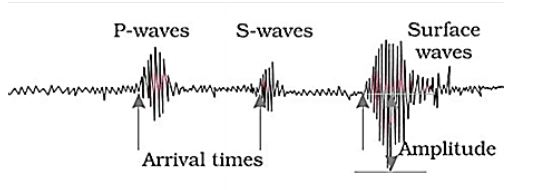
Earthquakes generate sound waves inside the earth. Unlike a gas, the earth can feel both transverse (S) and longitudinal (P) sound waves. Typically the speed of the S wave is about $ 4km{{s}^{-1}} $ and that of P wave is $ 8km{{s}^{-1}} $ . A seismograph records P and S waves from an earthquake. The first P wave arrives $ 4\min $ before the first S wave. Let us assume that the waves are travelling in a straight line, at what distance will the earthquake occur?
Answer
576k+ views
Hint: The concepts of distance and displacement have been used here. Distance is given as the total path length traversed by a body or a wave during the motion. Time taken to travel is given as the velocity divided by the distance travelled. These concepts may help you to solve this question.
Complete step-by-step answer:
Let $ {{V}_{S}} $ and $ {{V}_{P}} $ be the velocities of S and P waves respectively.
Let $ L $ be the distance between the epicentre and the seismograph.
We know that,
$ \begin{align}
& L={{V}_{S}}{{t}_{S}} \\
& L={{V}_{P}}{{t}_{P}} \\
\end{align} $
In which $ {{t}_{S}} $ and $ {{t}_{P}} $ are the respective times taken by the S and P waves in order to reach the seismograph from the epicentre.
It is already mentioned in the question that,
\[\begin{align}
& {{V}_{S}}=4km{{s}^{-1}} \\
& {{V}_{P}}=8km{{s}^{-1}} \\
\end{align}\]
From the equations of the distance between the epicentre and seismograph,
We can write that,
\[{{V}_{S}}{{t}_{S}}={{V}_{P}}{{t}_{P}}\]
Substituting the values in it will give,
\[4\times {{t}_{S}}=8\times {{t}_{P}}\]
Therefore,
\[{{t}_{S}}=2\times {{t}_{P}}\]
And it is also mentioned in the question that,
\[{{t}_{S}}-{{t}_{P}}=4\min \]
Comparing both the equations will give,
\[2\times {{t}_{P}}-{{t}_{P}}=4\min =240s\]
That means,
\[{{t}_{P}}=240s\]
Thus
\[{{t}_{S}}=480s\]
Therefore from the equation regarding length cited above can be written as,
\[L={{V}_{S}}{{t}_{S}}\]
Substituting the values in the equation,
\[L=4\times 480=1920km\]
Therefore the answer is obtained.

Note: Seismic waves are referred to as the waves of energy as a result of the sudden breaking of rock within the earth or by an explosion. They are the energy that can travel through the earth. These are recorded using a seismograph.
Complete step-by-step answer:
Let $ {{V}_{S}} $ and $ {{V}_{P}} $ be the velocities of S and P waves respectively.
Let $ L $ be the distance between the epicentre and the seismograph.
We know that,
$ \begin{align}
& L={{V}_{S}}{{t}_{S}} \\
& L={{V}_{P}}{{t}_{P}} \\
\end{align} $
In which $ {{t}_{S}} $ and $ {{t}_{P}} $ are the respective times taken by the S and P waves in order to reach the seismograph from the epicentre.
It is already mentioned in the question that,
\[\begin{align}
& {{V}_{S}}=4km{{s}^{-1}} \\
& {{V}_{P}}=8km{{s}^{-1}} \\
\end{align}\]
From the equations of the distance between the epicentre and seismograph,
We can write that,
\[{{V}_{S}}{{t}_{S}}={{V}_{P}}{{t}_{P}}\]
Substituting the values in it will give,
\[4\times {{t}_{S}}=8\times {{t}_{P}}\]
Therefore,
\[{{t}_{S}}=2\times {{t}_{P}}\]
And it is also mentioned in the question that,
\[{{t}_{S}}-{{t}_{P}}=4\min \]
Comparing both the equations will give,
\[2\times {{t}_{P}}-{{t}_{P}}=4\min =240s\]
That means,
\[{{t}_{P}}=240s\]
Thus
\[{{t}_{S}}=480s\]
Therefore from the equation regarding length cited above can be written as,
\[L={{V}_{S}}{{t}_{S}}\]
Substituting the values in the equation,
\[L=4\times 480=1920km\]
Therefore the answer is obtained.

Note: Seismic waves are referred to as the waves of energy as a result of the sudden breaking of rock within the earth or by an explosion. They are the energy that can travel through the earth. These are recorded using a seismograph.
Recently Updated Pages
Why are manures considered better than fertilizers class 11 biology CBSE

Find the coordinates of the midpoint of the line segment class 11 maths CBSE

Distinguish between static friction limiting friction class 11 physics CBSE

The Chairman of the constituent Assembly was A Jawaharlal class 11 social science CBSE

The first National Commission on Labour NCL submitted class 11 social science CBSE

Number of all subshell of n + l 7 is A 4 B 5 C 6 D class 11 chemistry CBSE

Trending doubts
10 examples of friction in our daily life

One Metric ton is equal to kg A 10000 B 1000 C 100 class 11 physics CBSE

Difference Between Prokaryotic Cells and Eukaryotic Cells

1 Quintal is equal to a 110 kg b 10 kg c 100kg d 1000 class 11 physics CBSE

State the laws of reflection of light

Explain zero factorial class 11 maths CBSE




